Everything You Should Know About An Orthodontist

Start your journey to a perfect smile with our expert guidance and informative articles!
Table of Contents
What is An Orthodontist?
An orthodontist is a dentist who specializes in diagnosing, treating, and preventing abnormalities of teeth and face. They are experts in correcting misaligned teeth and jaws, which can improve both the function and appearance of a patient’s smile. Orthodontists undergo extensive training beyond dental school, including additional years of specialized education and clinical experience in orthodontics. This expertise allows them to use various treatments, such as braces, clear aligners, and other orthodontic appliances, to move teeth into the desired position gradually.
Orthodontists are essential to improving general well-being and dental health. Addressing issues like overcrowded or crooked teeth, overbites, underbites, and jaw alignment problems, they help patients achieve better oral hygiene, as properly aligned teeth are easier to clean and maintain. Additionally, orthodontic treatment can improve speech and chewing functions, reduce the risk of dental injuries, and boost self-confidence by creating a more attractive smile. Regular visits to an orthodontist ensure that treatment progresses smoothly and any adjustments are made promptly for optimal results.
What is the Difference Between An Orthodontist and a Dentist?
An orthodontist and a dentist differ primarily in their areas of training and expertise. While both are dental professionals, a dentist focuses on oral health, including routine check-ups, cleanings, fillings, and crowns, and treating general dental issues like cavities and gum disease. On the other hand, an orthodontist is a specialist who has undergone additional years of training precisely to diagnose, prevent, and treat dental and facial irregularities, such as misaligned teeth and jaws. While dentists manage a broader spectrum of dental care and maintenance, orthodontists employ braces, clear aligners, and other tools to remedy these abnormalities.
How Long Does Orthodontic Treatment Take?
Orthodontic treatment typically takes 18 months to 3 years, depending on the case’s complexity and the specific issues being addressed. Factors such as the type of orthodontic appliances used, the patient’s age, and how well they follow the orthodontist’s instructions can also influence the treatment duration. Routine examinations and modifications are crucial to ensure the treatment goes as intended and produces the intended effects.
Are Braces Painful?
Braces can cause discomfort, mainly after they are applied or adjusted. Patients often experience soreness or tenderness in their teeth and gums for a few days as their mouth adjusts to the new pressure exerted by the braces. Over-the-counter painkillers can alleviate this discomfort, usually going away in a week or less. Regular follow-ups with the orthodontist help to monitor and minimize any ongoing discomfort, ensuring a smoother treatment experience.
At What Age Should My Child See An Orthodontist?
According to the American Association of Orthodontists, children should get their first orthodontic evaluation by the age of seven. At this age, an orthodontist can identify potential issues with jaw growth and the alignment of emerging teeth, allowing for early intervention if necessary. This early evaluation helps plan the best time to start treatment, even if immediate action is not required. Early detection of issues can make future treatments more effective and less complex.
Early orthodontic intervention can also help shield the youngster from later, more severe issues. Early treatment can guide the growth of the jaw and incoming permanent teeth, helping to avoid the need for more extensive treatment later on. Moreover, early visits can provide parents with a better understanding of their child’s dental development and the steps needed to ensure a healthy, aligned smile as they grow.
Orthodontist FAQs
When wearing braces, avoid the following foods:
- Hard foods: nuts, popcorn, hard candies
- Sticky foods: gum, caramel, taffy
- Crunchy foods: chips, raw vegetables (unless cut into smaller pieces)
- Chewy foods: bagels, licorice
- Sugary foods: sugary snacks and sodas (to reduce the risk of cavities)
Yes, adults can get braces. Orthodontic treatment is not limited to children and teenagers; many adults seek braces to correct misaligned teeth, improve their bite, and enhance their smile. Advances in orthodontic technology have made it more convenient for adults to undergo treatment, with options like clear aligners (Invisalign) and less noticeable ceramic braces. Orthodontic treatment for adults can also address issues that impact oral health, such as jaw pain, gum problems, and difficulty chewing, making it a worthwhile investment for overall well-being.
Orthodontic treatment, while highly beneficial, can have some potential side effects. Common temporary side effects include discomfort or soreness in the teeth and gums, especially after adjustments. Patients may also experience mouth sores from the brackets or wires and minor irritation to the cheeks or lips. In rare cases, more serious issues like root resorption (shortening of the tooth roots), allergic reactions to the materials used, or changes in tooth color may occur. Good oral hygiene and regular orthodontic check-ups can help mitigate these side effects, ensuring a smoother treatment experience.
